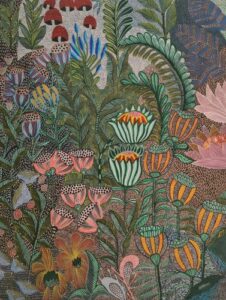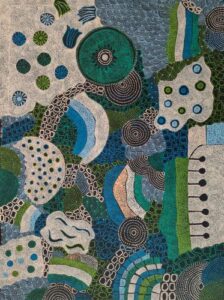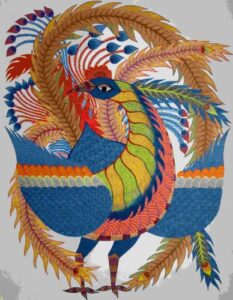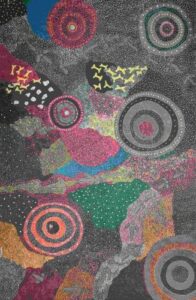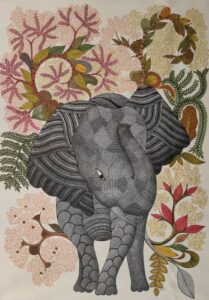Exhibition showcases how traditional tribal arts have moved ahead with times

Sundeep Bhandari, Founder, Gondwana Art Project
Rajkumari Sharma Tankha
Bikaner House, New Delhi is playing host to a tribal art exhibition, which is a collaboration between Gondwana Art Project and Australian artists. The show is being held in conjunction with India Art Fair as a parallel event. Focused on supporting tribal artists from the Gondwana region and create modern and contemporary art using their traditional art form and techniques, the exhibition titled Modern Tribal – Connecting Traditions is a visual delight that showcases how these cultural art forms are evolving with modern times.
“The Gond and Bhil art from central India have a remarkable similarity with the First Nation’s Art from Australia,” says Sundeep Bhandari, Founder, Gondwana Art Project, as he tells us more about the inception and journey of this art project:
What inspired you to start the Gondwana Art Project? When did it happen? How did you go about it and what all challenges came your way? How did you overcome those?
It emerged from my interest in traditional arts and crafts of our country. Each time I would go to see indigenous art exhibitions, I noticed that tribal arts were shown in their traditional formats, with very little attempt to get these tribal artists to evolve with modern times. These artists have fabulous inherent skills, however there was a fatigue factor creeping in as most Gond or Bhil artworks looked similar to each other. I decided to support tribal artists under my foundation by providing them livelihood while mentoring them to create artworks in modern and contemporary styles, keeping the authenticity of their art form intact
I founded the Gondwana Art Project (the word Gondwana is a geological term for the central plateau of India, which are also the largest tribal belts) in 2019 and we decided to support six artists to begin with as pilot project. The artists were selected through a process looking at their skill sets, their earnings from art, their willingness to experiment and evolve. We got a list of approximately 150 artists from the central Government and State Government databases and selected 6 artists to start the project.
In 2020 and subsequent 24 months, Covid created havoc in all our lives. Tribal artists had no work as their traditional markets – the melas and bazaars were all shut down and they had no income to sustain their livelihood. The Gondwana Art project decided to continue supporting the livelihood of these artists and continued to add more and more artists to the project.
Our challenge then was, how do we continue to sustain the project as I had already put in a substantial amount of my personal funds to support this project. We then established our website and our social media accounts and started putting artworks on our social media. The response from people globally was extremely heart-warming for me and people gave great reviews and started buying artworks from the project. Everything that we earned was put back into the project to continue expanding the project and supporting more and more tribal artists and artforms.
Flower Fields – Santoshi Shyam
How do you select artists? What’s the criteria? How are artists helped by it?
We have got a data base of tribal artists registered with Government organisations. The data base had over 150 artists and it was going to be a challenge for us to short list the initial six without a selection criteria.
The key criteria for us for selection of artists included, talent, their current earning levels (if they were already doing well, we did not want to intervene), their interest to learn new design concepts and use of Color palette, and their interest in experimenting.
The artists benefitted as they were allowed freedom to express with mentorship by designers from NIFT and NID on new design concepts and Color palette. Furthermore, the artists were provided an assured fee for every artwork they did irrespective of the outcome. This freedom to express with some mentorship allowed for creation of some of the best tribal artworks that have been done in recent times.
Rhythms- Santoshi Shyam
Please share some memorable collaborations or experiences with the artists involved?
The project collaborated with high end fashion brands like Jade, Shop Drawn, etc., as well as with organisations like Jawahar Kala Kendra, India Art Fair etc.
What are some notable achievements or milestones reached during the course of the project?
The Project supports the livelihood of 35 tribal artists practicing Gond, Bhil, Baiga, Sohrab, Kohbar, Paitkar, Warli, and Kurumba art forms. The project has been able to develop a large body of world class paintings done by tribal artists from central India. The Gondwana Art Project is followed by over 10,000 people from across the world, who love the work that is being done. Some of the artworks done under the project are now in collections of a few International museums.
Elephant – Jyoti Uikey
How many shows have you held so far?
The Gondwana Art project does an annual show since 2020 to coincide with the India Art Fair. The first of these annual exhibitions was held at Le Meredien Hotel in 2020, subsequently we held exhibitions at the Jawahar Kala Kendra, India International Centre, India Habitat Centre and now at the Bikaner House.
We have also collaborated with galleries to put up exhibitions at their centres.
How did the collaboration with Australian artists happen? How is the Gond and Bhil art from central India similar to the First Nation’s Art from Australia?
I have been intrigued with the similarities between Indian tribal art forms and the art of First Nations from Australia. We started a discussion with one of the largest regional art museums in Australia called NERAM (New England Regional Art Museum) to collaborate and showcase the Indian tribal art in Australia and via versa. The current exhibition provided a great platform to further the collaborative approach. NERAM’s Director Rachael Parsons will be attending the exhibition and doing a talk on the evolution of art of First Nations in Australia.
Both Bhil art as well as Gond art use dots, dashes and lines extensively. They are raw forms of art that can be presented in a sophisticated way with better design and Color palette. The art of First Nations Australia already commands an equal footing with modern and contemporary artworks and sometimes they are valued much more due to the intrinsic cultural aspects of the art form. Indian tribal art has suffered due to boundaries of the artworld separating tribal art from modern and contemporary art. The Gondwana Art Project hope to bring a revolution of change and get the tribal artists to develop their art in a modern and contemporary style for the global audience.
Universe – Chandrakali Pusham
How have you curated the artworks to best convey the project’s message in the current show?
This exhibition has been curated to showcase the similarities between Gond and Bhil art forms and arts of First Nations, Australia. The exhibition features some of the best tribal artworks done in India in recent times.
Are there any upcoming projects or expansions related to the Gondwana Art Project?
The Gondwana Art Project has started working with a Kurumba artist based in the Nilgiri’s. A Kurumba artwork done under the Project is being showcased at the parallel Times of India art Exhibition happening at the Habitat Centre.
Elephant – Jyoti Uikey
What are your future plans?
We are looking at more collaborations with museums and galleries across India as well as some of the major global cities, to showcase the evolving tribal art forms from India.
The show is on till February 5, 11 am to 7 pm at
Main Gallery, Bikaner House, New Delhi


